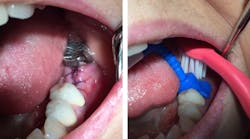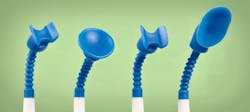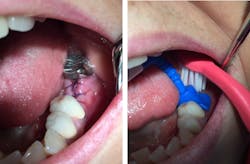Biofilm management is key to promoting healing following dental surgical procedures. In this article, Susan Wingrove shares her recommendations for postsurgical home care and makes several product recommendations.
Research shows that daily biofilm removal following extractions, implant placement, bone or soft-tissue grafting, augmentations, or other dental surgeries is the key to achieving optimal results. (1)
“After dental surgical procedures, patient biofilm management at home around the surgical site is a constant concern for clinicians, as plaque can lead to inflammation, delayed healing, and an increased risk of infection,” said Jim Stein, DMD. "One of the most difficult things for patients with sutures, following either a socket preservation or an implant placement procedure, is to clean the adjacent teeth without disturbing the surgical site.”
Take away the confusion for patients as they recover with a comprehensive postsurgical home-care routine to use for the two to three weeks following surgery. Develop a postsurgical guideline sheet that both the surgeon and the restorative doctor agree is safe and effective to prevent infection and promote healing, print the sheet, and share it with the patient. (2)
Example: Postsurgical home-care instructions
| ✓ | On the first day, drink only clear liquids. |
| ✓ | For the next few days, eat a soft diet. |
| ✓ | Take antibiotics and pain medications as prescribed. |
| ✓ | Brush with an extra-soft manual toothbrush to clean teeth and gums. Do not brush the surgical site. Wait two weeks to use a power toothbrush. |
| ✓ | Floss once a day except at the surgical site. |
| ✓ | Avoid wearing a temporary prosthesis to let the tissue heal. |
| ✓ | Use a salt-water rinse or an alcohol-free antimicrobial rinse two times daily, if prescribed. |
To give patients confidence and improve their compliance with the postsurgical guidelines, provide them with the proper tools and products: a Mouth-Mate device, an extra-soft toothbrush, a compact tuft brush, a pH-neutral toothpaste, and an antimicrobial mouth rinse.
Most patients are afraid to brush near the wound after dental surgical procedures, so they avoid that part of the mouth. Biofilm accumulates on the teeth or implants adjacent to the surgical site, detaches, and migrates to the surgical site. (1)
Mouth-Mate (Armor Dental) is a new tool that has emerged to improve patient home-care compliance. Eliminate the patient’s worry of harming the surgical site while brushing the adjacent teeth by providing a Mouth-Mate device to cover the surgical site. Mouth-Mate decreases complications by preventing contamination and infections, and ultimately by improving procedure outcomes. Mouth-Mate devices are available in three different designs for the patient to cover the incision area, extraction site, or implant while complying with your home-care instructions (figure 1).
Figure 1: The different Mouth-Mate designs: U-shaped for implant, bone grafting, and extraction sites (small and large); circle-shaped for wisdom tooth extraction sites; and oval-shaped for soft-tissue grafting sites.
The patient holds the Mouth-Mate to cover the surgical site and brushes the adjacent teeth without disturbing the surgical site (figures 2 and 3).
Figures 2 and 3: A bone-graft patient using the Mouth-Mate (image courtesy of Roy Sonkin, DDS)
Equally important for the postsurgical routine is choosing a mouth rinse that is antimicrobial, antiviral, and antifungal, such as a chlorine dioxide rinse (e.g., CloSys, Rowpar Pharmaceuticals) to help the patient create an ideal oral environment for promoting healing. Chlorine dioxide is recommended to remove biofilm, germs, and volatile sulfur compounds (VSCs) associated with periodontal and peri-implant disease. It is a pH-balanced, alcohol-free, nonburning rinse that is effective and comfortable for the patient to use twice daily. Most importantly, research supports recommending stabilized chlorine dioxide as a pre- and postprocedural rinse for all dental procedures. (3)
On the other hand, research shows that chlorhexidine controls plaque but should not be used for regenerative procedures because it can wick into subgingival areas and destroy the friable new granulations from the periodontal ligament or bone. (3) Chlorine dioxide is safer and more effective for cells during periodontal and bone wound healing. (3)
“Clinicians can now have an impact on patients' recovery at home following dental surgical procedures, which will improve healing and comfort,” Zori Rabinovitz, DMD, MS.
Improve patient compliance by providing clear guidelines, tools, and products to prevent infection, promote healing, and make home care comfortable during the recovery from dental surgical procedures.
Editor's note: This article first appeared in Pearls for Your Practice: The Product Navigator.Click here to subscribe. Click here to submit a products article for consideration.
References
1. Quirynen M, De Soete M, van Steenberghe D. Infectious risks for oral implants: a review of the literature. Clin Oral Implants Res. 2002;13(1):1-19.
2. Wingrove S. Peri-Implant Therapy for the Dental Hygienist: Clinical Guide to Maintenance and Disease Complications. Oxford: Wiley-Blackwell; 2013.
3. Wirthlin MR, Ahn BJ, Enriquez B, Hussain MZ. Effects of stabilized chlorine dioxide and chlorhexidine mouth rinses in vitro on cells involved in periodontal healing. J West Soc Periodontol Periodontal Abstr. 2006;54(3):67-71.









